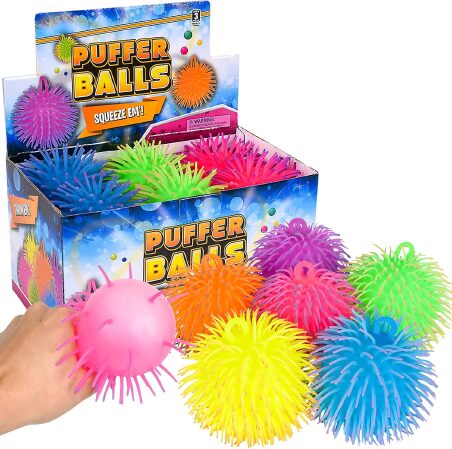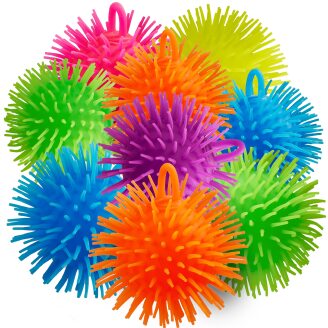In today’s globalized business environment, international wholesale buyers should not only consider the quality and price of products when choosing products, but also pay attention to the safety of products, especially for products like Puffer Ball that may involve health and safety risks. This article will explore in depth how to judge whether Puffer Ball is toxic, and provide professional purchasing advice for international wholesale buyers to help them make wise decisions.
1. Understand the common types of Puffer Ball
Puffer Ball is a popular toy that is usually made of elastic material and filled with various substances in the middle, such as gel, foam beads, etc. According to different fillings and designs, Puffer Ball can be divided into many types, such as gel-filled Puffer Ball, foam bead-filled Puffer Ball, water bead-filled Puffer Ball, etc. Each type has its own unique characteristics and potential safety risks. For example, gel-filled Puffer Ball may contain certain chemicals, while foam bead-filled Puffer Ball may have the risk of suffocation caused by small parts falling off.
2. Check material safety
Material is one of the key factors in determining whether Puffer Ball is toxic. When choosing Puffer Ball, buyers should ask suppliers to provide material safety data sheets (MSDS) or related certification documents to ensure that the materials used meet international safety standards. Common safety materials include non-toxic gel, polyurethane foam, food-grade TPR, etc. In addition, attention should be paid to whether the materials contain harmful chemicals, such as bisphenol A (BPA), phthalates, etc., which may cause harm to human health.
3. Pay attention to product certification
Product certification is an important basis for judging the safety of Puffer Ball. In the European market, Puffer Ball needs to obtain CE certification to prove that it complies with the requirements of EU health, safety and environmental regulations. CE certification covers the Toy Safety Directive 2009/48/EC and the EN 71 series of standards, which put forward detailed technical requirements for the mechanical and physical properties, flammability, chemical properties and other aspects of toys. In addition, the RoHS directive also restricts the use of certain harmful substances in Puffer Ball, such as lead, mercury, cadmium, etc. In other markets, such as the United States, there are also corresponding safety certification standards, such as CPSIA and ASTM F963. Buyers should ensure that the Puffer Balls they purchase meet the relevant certification requirements of the target market.
4. Conduct professional testing
In order to more accurately determine whether Puffer Balls are toxic, buyers can entrust professional third-party testing agencies to test the products. These testing agencies usually have advanced testing equipment and professional technicians, and can analyze the various ingredients in Puffer Balls to detect whether they contain toxic substances and whether they meet relevant safety standards. Testing projects may include chemical composition analysis, physical property testing, toxicity assessment, etc. Through professional testing, buyers can obtain detailed product safety reports to provide a scientific basis for purchasing decisions.
5. Refer to customer reviews and market feedback
Before purchasing Puffer Balls, it is also very important to understand other customers’ comments on the product and market feedback. Customer reviews can reflect the safety and quality of the product in actual use. If multiple customers report that the product has toxicity problems or causes health problems, then buyers should carefully consider whether to purchase the product. In addition, market feedback can also help buyers understand the reputation and market acceptance of the product, so as to make more informed purchasing decisions.
6, communicate with suppliers
Full communication with suppliers is an important part of ensuring procurement safety. Buyers should clearly inform suppliers of product safety requirements and require suppliers to provide detailed product information and relevant certification documents. At the same time, understand the supplier’s production process and quality control measures to ensure that the supplier has good production management and quality assurance capabilities to reduce the possibility of toxic risks in the product.
7, pay attention to industry trends and regulatory updates
The toy industry is developing rapidly, and relevant safety regulations and standards are constantly being updated. Buyers should pay close attention to industry trends and regulatory changes, and adjust procurement strategies and requirements in a timely manner. By participating in industry exhibitions, seminars and other activities, buyers can learn about the latest product safety information and technological developments, exchange experiences with peers, and improve their own procurement decision-making capabilities.
8, summary
In international wholesale procurement, it is crucial to ensure the safety of Puffer Ball. Buyers need to comprehensively consider multiple aspects such as product type, material safety, certification status, professional test results, customer evaluation, supplier communication, and industry trends to comprehensively evaluate whether Puffer Ball has toxic risks. By taking the above measures, buyers can effectively reduce procurement risks and provide customers with safe and reliable products, thereby winning customers’ trust and market share in the fierce market competition.
Post time: Mar-28-2025

